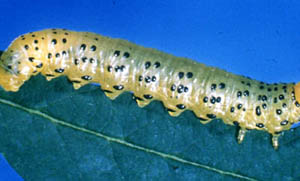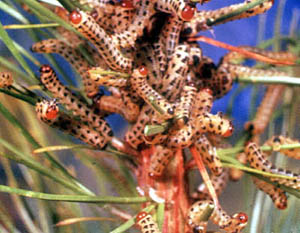Sawflies


Adults resemble bees or small wasps. Larvae resemble caterpillars, except they have more than five pairs of abdominal prolegs. Most species have one to two generations a year, and pupae overwinter in soil. Most sawfly larvae are ½ to 1 inch long. Most are external feeders on foliage. Some eat needles, some eat entire leaves, while others only skeletonize leaves of shrubs and trees. Cocoons may be formed on foliage, twigs, or in the ground.
As a group, sawflies have a wide host range. They feed on conifers, as well as various oaks, roses, black locust, azaleas, ash, black walnut, elm, and some woody ornamentals.
Look for symptoms of localized defoliation or skeletonized leaves on exposed branches and shoots of coniferous and deciduous trees and shrubs. Look for clusters of spotted or striped larvae in the vicinity of damage symptoms.
Small infestations may be manually removed and destroyed. Large infestations of young larvae may be sprayed with horticultural oil. Nearly mature larvae may be sprayed with a contact insecticide. Sawfly larvae are not caterpillars; Bacillus thuringiensis formulations for caterpillar control will not affect these pests.
